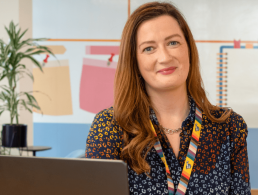Henkel’s Cormac Duffy discusses his work in adhesive technologies and his particular focus on cyanoacrylates.
“I’ve always had an interest in science, particularly chemistry and physics,” says Cormac Duffy, a scientific principal working in the Strategic Research Group at Henkel. This interest lead him to study chemical and pharmaceutical science at Dublin City University (DCU).
“The research projects and work experience I was involved in during my time at DCU made me determined to pursue a career in research and I managed to secure a position with Henkel in 2008, which at the time, was one of the few truly industrial R&D facilities in the country.”
Over the course of his 15-year career with Henkel, Duffy has worked with a wide range of technologies, but has primarily focused on the area of instant adhesive technology referred to as cyanoacrylates.
In 2017, he obtained a PhD in polymer chemistry from the University of Galway, which was sponsored by Henkel. In his current role, he researches smart adhesives for industrial asset bonding applications.
“Developing next-generation technologies is quite challenging and requires a lot of problem-solving, troubleshooting and verification but it’s all the more rewarding when you successfully get from a concept to a functional prototype.”
‘In strategic research there is a lot of critical and design thinking involved’
If there is such a thing, can you describe a typical day in your role?
Happily, I can say that no two days in Henkel are ever the same; each day comes with new developments and challenges. Daily activities can range anywhere from testing and experimenting in the lab, studying academic and technical literature online, interpreting analytical data, writing reports, giving project presentations, meeting with external researcher partners, customers or suppliers, or just discussing our projects as a group. The Strategic Research Group collaborates strongly as a team, discussing experimental observations and offering suggestions and ideas to help each other out and further the project goals.
I really enjoy collaborating with others. Henkel has such a rich community of different backgrounds and experience, not only locally but also internationally. If you have a technical question there is always someone who has the answer or knows someone that does. It also lends to a great diversity of thought, offering varied perspectives when brainstorming ideas or troubleshooting technical hurdles. People are always willing to help and support others.
What types of projects are you currently working on, especially in the realm of smart adhesives?
Smart adhesives are at the core of the strategic group’s focus. We have exciting projects where we are looking at polymers and polymer composites that can activate unique properties when subjected to particular external stimuli. Also, with increased importance on sustainability and new right-to-repair initiatives, there is a growing demand for debondable adhesives, which are adhesives that have high bond strengths in normal working conditions but have a built-in trigger so that when they are exposed to specific conditions they will break apart or lose their bond strengths and allow the bonded parts to be reused or recycled.
One previous project I particularly enjoyed working on was bonding two different lightweight metal substrates for an automotive application. The two metals have very different coefficients of thermal expansion meaning that when they are exposed to high thermal stress, they expand at differing rates which can be a huge challenge when these are adhesively bonded together and can lead to bond fatigue or failure. The aim was to develop a corrosion-resistant flexible adhesive to bond these mixed-metal substrates that could retain high bond strengths at elevated temperatures. This was an incredibly challenging task, but the team was able to successfully deliver a now patented solution. For me, it was a much more material science-oriented project and gave great experience into epoxy adhesive chemistry.
What skills do you utilise on a daily basis?
In strategic research there is a lot of critical and design thinking involved. You are constantly looking for innovative solutions to solve technical hurdles and overcome challenges to address a customer’s application needs. This often involves trying to look at an issue from different perspectives, breaking it down into different components and attempting to solve it using multiple different approaches while drawing from the experience of previous projects and technologies.
What were the biggest surprises or challenges you encountered in your 15-year career at Henkel and how did you navigate them?
Working with cyanoacrylate adhesives is always a challenge! They are so incredibly reactive and sensitive that any minute change to an adhesive formulation or processing method can have a dramatic impact on product performance or stability.
It still amazes me that even though they have been considered by many to be a mature chemistry, cyanoacrylates continue to find innovative technology breakthroughs and exciting new application areas even 80 years since their discovery.
Do you have any productivity tips that help get you through the day?
I’m a big advocate of a simple to-do list. At the end of every day, I write up a list for the next workday so the following morning I can coordinate, prioritise and arrange my activities with the day’s schedule. I like to think I can multitask but in reality, I’m just easily distracted and jump between different tasks or respond to a new email that has just come in, so I try to keep focused by setting one task to complete and sticking with it until its done.
What do you enjoy most about your job?
I particularly enjoy the creative freedom to experiment and test out new inventive concepts. Henkel has a great culture of innovation that encourages you to scout out your ideas, new application areas or improvements that can be made.
In strategic research, working with breakthrough technology areas means there is ultimately a lot of trial and error but using scientific methods to investigate and explain why a system is behaving in a particular way can be quite interesting and satisfying when a mystery is solved.
How has your role evolved with the growing emphasis on smart solutions for industrial applications?
It definitely feels like there is a focus more toward material science aspects of smart solutions, rather than the traditional organic and polymer chemistry solutions. Industrial applications have become much more complex and sophisticated and so our adhesive solutions need to keep up. The advancing technologies we are exploring are expanding into lots of different fields and disciplines of science from chemical physics to mechanics, electronics and even industrial engineering!
Some days it can feel like you’re back in a lecture hall when you’re learning about new concepts or analytical techniques but it’s great to keep building on your knowledge base and strengthening your skills.
What advice would you give to those considering a career in this area or a similar field?
If you’re scientifically minded, enjoy problem-solving and you think you might like a career in research, then push for it! Try it and find out!
10 things you need to know direct to your inbox every weekday. Sign up for the Daily Brief, Silicon Republic’s digest of essential sci-tech news.




